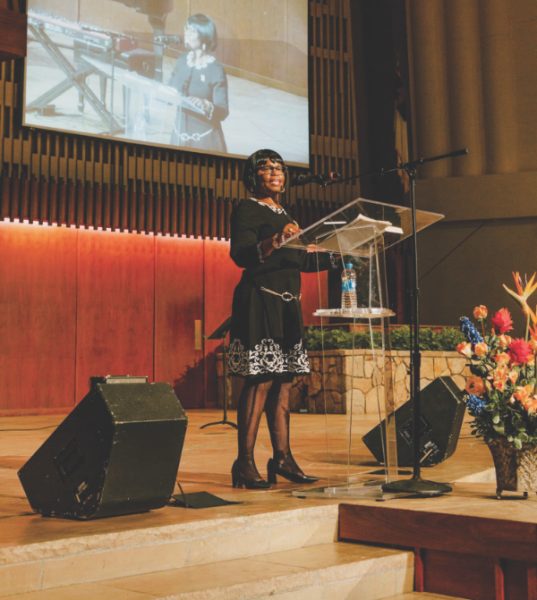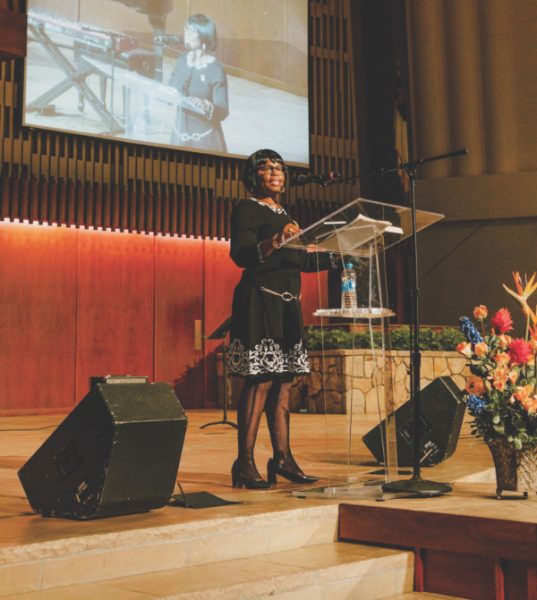
The sisters giggled as they walked down the avenue to church in their Sunday best. Even the gray clouds couldn’t dampen their spirit. It was Youth Day, and they would be singing up front in the choir.
Once they arrived, they slipped into the basement ladies’ lounge to freshen up. Then Denise, Cynthia, and Carole came in and joined their friends. At the washbasin, Denise turned and asked if Addie Mae would tie her dress. The last thing young Sarah saw was her older sister’s hands reaching out for the sash.
Then the room exploded.
Nearly 60 years later, Sarah Collins Rudolph, the little girl who survived one of the darkest days in civil rights history, told her story to Pacific Union College students at a special Community on Thursday, Jan. 12, to commemorate Martin Luther King Jr. Day.
With her gentle Southern accent, Rudolph told the students about Birmingham, Alabama, in the 1960s. About the atrocious Jim Crow laws that prohibited nearly every interaction between Black and white residents.
Martin Luther King Jr. and other civil rights activists often met at 16th Street Baptist Church—one of the largest Black churches in Birmingham—through the spring of 1963. They were met with fierce resistance.
On Sept. 15, 1963, four young Ku Klux Klansmen planted at least 15 sticks of dynamite attached to a timing device in the basement of the church. Right near the ladies’ lounge, where the five girls were getting ready to sing.
At 10:22, it detonated.
Despite the force of the blast, Rudolph stood in the jumble of wreckage around her. But she couldn’t see. First, she called for Jesus, she said. Then her sister.
The Rev. John Cross ran into the now-gaping hole in the basement, scooped Rudolph up in his arms, and took her to the ambulance.
Four girls died in the blast: Denise McNair, 11; Cynthia Wesley, 14; Carole Robertson, 14; and Addie Mae Collins, 14.
Only “the fifth girl”—as she’s often referred to now—survived: 12-year-old Sarah.
She was badly injured but alive. Rudolph’s left eye was eventually removed and replaced with a prosthetic, and doctors removed 26 shards of glass from her face.
But worst of all, Rudolph told PUC students, was the realization that these girls had died in a safe place—in church.
She became nervous and fearful of going places. If a car backfired, she’d jump. She’d shake in church.
Later, she said, the pastor called her up on stage to pray for healing for her anxious condition.
“Now,” Rudolph told the PUC students, faculty, and staff, “I can go places. I can talk about Jesus.”
“I had to forgive the men that bombed that church,” she said. “I carried a lot of hate in my heart for what they did to those girls and myself. So I forgave them and really started to live my life again.”
PUC senior Keren Castro, a photography major, said she thought it was “encouraging” to hear how “Rudolph went through such a traumatic event but was still able to find peace in her heart and forgive those who did this to her.”
“It was a powerful story that really resonated with the students,” PUC Vice President of Student Life Ryan Smith said. “It’s one thing to read about these types of histories, it’s another to hear it from the person live when you can hear and feel the emotions.”
The 16th Street Baptist Church bombing was among the most high-profile events of the civil rights movement. In part, it contributed to Congress finally passing the Civil Rights Act of 1964.
____________________
By Laura Gang
Sobreviviento del atentado a la iglesia de Birmingham en 1963 comparte su historia

Las hermanas reían mientras caminaban por la avenida hacia la iglesia en su mejor ropa dominical. Incluso las nubes grises no podían opacar su espíritu. Era el Día de la Juventud y estarían cantando en el coro.
Una vez que llegaron, se dirigieron al salón de damas del sótano para refrescarse. Después Denise, Cynthia y Carole entraron y se unieron a sus amigas. En el lavabo, Denise se volvió y preguntó si Addie Mae le ataría el vestido. Lo último que vio la joven Sarah fueron las manos de su hermana mayor extendiendo el listón.
Fue entonces que la habitación explotó.
Casi 60 años después, Sarah Collins Rudolph, la niña que sobrevivió a uno de los días más oscuros en la historia de los derechos civiles, contó su historia a los estudiantes de Pacific Union College en una reunión especial conmemorando el Día de Martin Luther King Jr.
Con su suave acento sureño, Rudolph les contó a los estudiantes sobre Birmingham, Alabama, en la década de 1960. Sobre las atroces leyes de Jim Crow que prohibían casi todas las interacciones entre residentes negros y blancos.
Martin Luther King, Jr. y otros activistas de derechos civiles a menudo se reunían en la Iglesia Bautista de la Calle 16, una de las iglesias negras más grandes de Birmingham, durante la primavera de 1963. Se encontraron con una feroz resistencia.
El 15 de septiembre de 1963, cuatro jóvenes miembros del Ku Klux Klan plantaron al menos 15 cartuchos de dinamita unidos a un dispositivo de sincronización en el sótano de la iglesia. Justo al lado del salón de damas, donde las cinco chicas se preparaban para cantar.
A las 10:22, la dinamita detonó.
A pesar de la fuerza de la explosión, Rudolph se quedó entre los escombros. Pero ella no podía ver. Primero, ella clamó a Jesús, dijo. Después llamó a su hermana.
El reverendo John Cross corrió hacia el hueco ahora abierto en el sótano, tomó a Rudolph en sus brazos y la llevó a la ambulancia.
Cuatro niñas murieron en la explosión: Denise McNair, de 11 años; Cynthia Wesley, de 14 años; Carole Robertson, de 14 años; y Addie Mae Collins, de 14 años.
Solo «la quinta niña», como se le conoce a menudo ahora, sobrevivió: Sarah, de 12 años.
Estaba gravemente herida, pero viva. El ojo izquierdo de Rudolph finalmente fue removido y reemplazado por una prótesis, y los médicos retiraron 26 fragmentos de vidrio de su cara.
Pero lo peor de todo, dijo Rudolph a los estudiantes de PUC, fue darse cuenta de que esas niñas habían muerto en un lugar seguro: en la iglesia.
Se puso nerviosa y temerosa de ir a lugares. Si un auto petardeaba, daba un salto. Temblaba en la iglesia.
Más tarde, dijo, el pastor la llamó al escenario para orar por la curación de su ansiosa condición.
«Ahora», dijo Rudolph, «puedo ir a lugares. Puedo hablar de Jesús».
«Tuve que perdonar a los hombres que dinamitaron esa iglesia», dijo. «Llevaba mucho odio en mi corazón por lo que nos hicieron a esas chicas y a mí. Así que los perdoné y realmente comencé a vivir mi vida de nuevo».
Keren Castro, estudiante de último año de fotografía de PUC, dijo que pensaba que era «alentador» escuchar cómo «Rudolph pasó por un evento tan traumático, pero aún así pudo encontrar paz en su corazón y perdonar a quienes le hicieron eso».
«Fue una historia impactante que realmente resonó con los estudiantes», dijo el vicepresidente de vida estudiantil de PUC, Ryan Smith. «Una cosa es leer sobre ese tipo de historias, otra es escucharlo de la persona en vivo cuando puedes escuchar y sentir sus emociones».
El atentado de la Iglesia Bautista de la Calle 16 fue uno de los eventos de más alto perfil del movimiento de derechos civiles. En parte, contribuyó a que el Congreso finalmente aprobase la Ley de Derechos Civiles de 1964.
____________________
Por Laura Gang





